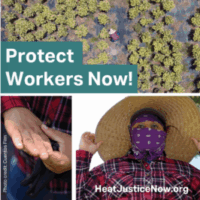Advocates Back Federal Legislation for $12.50 Wage
Washington, DC – As a new Congress prepares to receive President Obama for his State of the Union Address, a new poll shows overwhelming public support for wages well in excess of proposals being considered in Congress.
The poll, conducted by Hart Research Associates, shows that 75% of Americans – including 53% of Republicans – support an increase in the federal minimum wage to $12.50 by 2020, and that 71% of Americans believe the minimum wage for tipped workers should be increased so that all workers are subject to the same wage floor. The poll (and related memo) also shows that 63% of Americans support an even greater increase in the minimum wage to $15.00 by 2020.
“The findings here are very clear: Americans, regardless of region, socioeconomic status, or demographic distinction, strongly favor a very significant increase in the federal minimum wage,” said Guy Molyneux of Hart Research Associates.
Key advocacy groups – including the National Employment Law Project, the Economic Policy Institute, the National Women’s Law Center, the National Council of La Raza, and the Leadership Conference on Civil and Human Rights – are now calling for new federal legislation that would increase the national minimum wage to $12.50 by 2020, index future increases to keep pace with the rise in overall wages, and gradually phase out the subminimum wage for tipped workers.
“Stagnant income is the crisis of our time, and now is the moment for Congress to act boldly to address it, using one of the most potent tools at its disposal,” said Christine Owens, executive director of the National Employment Law Project. “The American people are way ahead of lawmakers on this issue. They have seen cities and states aggressively raise pay while continuing to thrive economically, and they want Washington to do the same.”
“A $12.50 minimum wage by 2020 is a simple and direct way to boost wages for 35 to 40 million workers and their families,” said Larry Mishel, president of the Economic Policy Institute. “It is also a boon for our economy overall, as this wage growth will fuel household spending that helps Main Street businesses grow.”
In the past two years, thousands of workers have taken to the streets to protest their low pay, with fast food workers now being joined by retail workers, home health care workers, and airport workers in their movement for a $15 wage. Spurred by this growing outcry, more than 30 states, cities and counties have passed minimum wage increases via legislation or ballot. As a result, 29 states plus the District of Columbia now have a minimum wage above the current federal minimum of $7.25. By 2017, 13 states and DC – representing nearly one-third of the U.S. workforce – will have minimum wages of $9 or more, and seven states and DC will be above the $10 level. At the local level, Seattle and San Francisco have passed laws that will phase in a $15 minimum wage, and Chicago’s minimum wage is rising to $13.
“The federal minimum wage was always intended to be a floor on which cities and states – and workers and employers, through collective bargaining – could build on,” added Christine Owens. “It no longer plays that role, and it is falling so far behind that modest increases are not enough.”
By two key measures, an increase in the minimum wage to $12.50 is in line with historical experience. First, a $12.50 wage represents just over 55% of the projected median wage in 2020, a key benchmark economists use to assess the economic viability of a particular wage. This represents a return to 1968 levels, a time when national unemployment was below 4%. Second, the average annual increase under this proposal (11.5%) is comparable to the average annual increase under all previous minimum wage hikes since 1961 (11.7%).
As the recovery from the Great Recession continues to unfold and unemployment rates slowly trend down, new job growth remains disproportionately concentrated in lower-wage industries such as retail and food services, making an increase in the minimum wage an urgent priority for growing numbers of working families who rely on low-wage work to make ends meet. A plurality (43 percent) of new jobs created from the start of the recovery through July 2014 have been in lower-wage industries, which employ 2.3 million more workers today than at the start of the recession.
Meanwhile, corporate profits are at an all-time high when measured as a share of the country’s gross domestic product, and corporate CEOs now earn over 330 times the wage of the average worker.
DOWNLOAD THE POLL AND EXPLANATORY MEMO.
Full List of Organizations Supporting $12.50 Proposal
9 to 5/National Organization of Working Women
Action for the Common Good
Americans United for Change
Coalition on Human Needs
Economic Policy Institute
Leadership Conference on Civil and Human Rights
Moms Rising
National Council of La Raza
National Employment Law Project
National Women’s Law
Restaurant Opportunities Center
USAction
###
The National Employment Law Project is a non-partisan, not-for-profit organization that conducts research and advocates on issues affecting low-wage and unemployed workers. For more about NELP, visit www.nelp.org or www.raisetheminimumwage.org.


